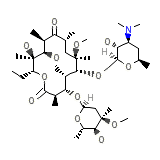Clarithromycine




Categoria
Clarithromycine Nombres de marca, Clarithromycine Analogos
Clarithromycine Marca los nombres de mezcla
Clarithromycine Formula quimica
Clarithromycine RX enlace
Clarithromycine FDA hoja
Clarithromycine MSDS (hoja de seguridad de materiales)
Clarithromycine Sintesis de referencia
Clarithromycine Peso molecular
Clarithromycine Punto de fusion
Clarithromycine H2O Solubilidad
Clarithromycine Estado
Clarithromycine LogP
Clarithromycine Formas de dosificacion
Clarithromycine Indicacion
Clarithromycine Farmacologia
Clarithromycine Absorcion
Clarithromycine Toxicidad
Clarithromycine Informacion de Pacientes
Clarithromycin is an antibiotic used to treat infections such as sinus infections, throat infections, tonsil infections and other lung related infections. It can be used by some patients to prevent infections. It is important that you take this medication for the full period of time your doctor has prescribed it, even if you feel better after a day or two. This medication should not be taken by those with an allergy to erythromycin. There are several significant drug interactions with clarithromycin. Make sure to have your doctor or pharmacist fully evaluate all medications you might be taking and ask them about drug interactions. The most common side effects reported include taste disturbances, diarrhea and nausea, occurring in approximately 3% of patients. Clarithromycin can be taken with or without food. Unlike other suspensions (liquid forms), this suspension should not be refrigerated.














